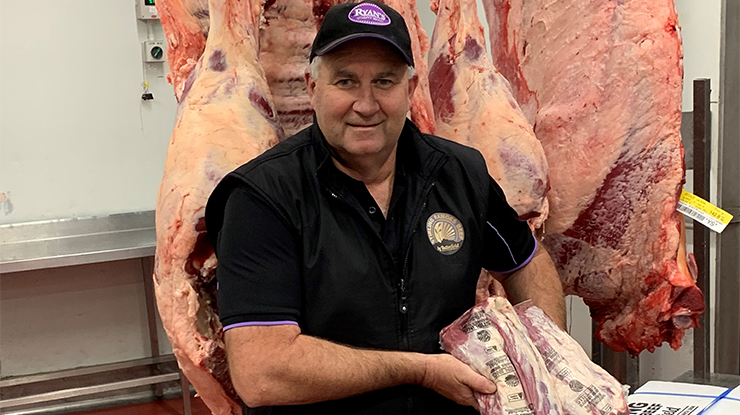 Greg Ryan, Ryan’s Quality Meats, WA.
Greg Ryan, Ryan’s Quality Meats, WA.
For award-winning WA butcher Greg Ryan, the Meat Standards Australia (MSA) program is critical to guaranteeing the beef for his retail, wholesale and foodservice customers is a consistently quality product, regardless of cut.
With business partner Karl Osterberg, Greg owns and operates Ryan’s Quality Meats (RQM), a second-generation family-run business originally founded by his father, Denis.
Greg works directly with WA beef producer and brand owner, Paul O’Meehan, from Butterfield Beef, as well as processor V&V Walsh to supply beef for Ryan’s Quality Meats, which allows RQM to follow the cattle the whole way through the supply chain.
Butterfield Beef is underpinned by the MSA program, turning off grass-reared, grain-finished Angus and Angus-cross cattle for the premium beef brand, Stirling Ranges Beef.
RQM is the sole wholesale distributor of Stirling Ranges Beef in Australia, supplying customers from its two locations at Jandakot in the Perth metropolitan area and in Bunbury.
Butcher-producer relationship key
Greg said working closely with Paul and their processor, and examining MSA data was key to achieving the right carcase specifications to supply a uniquely WA experience to the market.
“Cattle that supply the Stirling Ranges Beef brand are finished on grain for between 70-100 days, to a carcase weight of 270 kg to 310kg,” Greg said.
“We use MSA data to target carcases which ideally have an MSA marbling of 400, or AUS-MEAT marble score 2+.
“Paul has long-term relationships with the producers he sources cattle from in both the state’s south west and Great Southern regions, and he grows all the grain for the feed ration the cattle are finished on.
“We are looking for improved marbling all the time, so we know it’s only going to get better.
“In WA, marbling can be an issue because it’s a younger cattle market. The cattle are turned off at a lot younger age than they are on programs in the eastern states. However, we have been educating our customers whether retail, foodservice or wholesale about the importance of quality and consistency, and we now have some retail customers driving 60km or more on a Saturday morning to buy Stirling Ranges Beef from our retail sites.
“The science behind the MSA program helps us identify and maintain consistency from paddock to plate. MSA gives us the confidence that opportunity cuts will meet our customer’s expectations.”
Greg said his relationship with an MSA-accredited producer like Butterfield Beef had proven even more vital since the impact of COVID-19 restrictions had hit.
“The close relationship we share between a butcher and a producer is extremely rare, but it’s very important to us, and none more so than when COVID-19 restrictions came into play, and the first big rush of customers came in to stock-up.
“The relationship with Butterfield Beef gave us the flexibility to continue to meet our customer’s needs during this period.”
MSA important, regardless of cut
With demand for opportunity cuts flourishing at both a retail and foodservice level, MSA has helped the business be nimble in its response to rapidly changing customer demands.
“Our business, pre-COVID-19, was 8-9% retail (currently 25% of sales), 65% foodservice and the rest wholesale,” Greg said.
“Prime cuts are very hard to move in foodservice at the moment and those foodservice customers that are looking to reopen are looking more to opportunity cuts.
“We are having some success in moving more prime cuts in the retail market. For example, we had an oversupply of tenderloins due to foodservice closing, so we created a beef biscayne value-added product – we wrapped denuded Stirling Ranges Beef tenderloins in bacon and pork skin, and sold 90 of those for Mother’s Day alone.
“The fact we’re still doing 60 bodies a week through the business in these different and uncertain times is testament to the quality of the beef, the integrity of the MSA program, and due to our long-term producer and processor relationships, and our ability to adapt.”
Follow Ryan’s Quality Meats:




